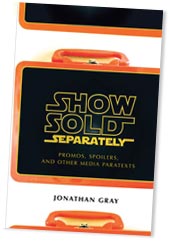The story continues off-screen for movies, TV shows
Even if you haven’t seen “Avatar,” you may have caught the movie’s trailer on television, heard its characters are blue and 10 feet tall, or know it was directed by James Cameron of “Titanic” and “Terminator” fame. Based on those tidbits, you may have decided you’re dying to see the blockbuster or you’d rather watch paint dry.
Seeing a movie or watching a new television show “cold” isn’t really possible, even for the most passive media consumers, says Jonathan Gray, an associate professor of media and cultural studies at UW–Madison.

“There’s a large number of people out there who make all sorts of judgments based on media that they haven’t seen,” Gray says.
In his new book, “Show Sold Separately: Promos, Spoilers, and other Media Paratexts,” Gray explores the impact of the flood of information from print media, trailers, Internet discussions, merchandising, podcasts and guerrilla marketing that viewers receive about movies and television shows. The book looks at examples including DVD bonus materials for “The Lord of the Rings,” spoilers for “Lost” and reviews for “Friday Night Lights.”
Audiences create some of this material, through activities such as writing fan fiction that takes characters in new directions and engaging in heated discussions about potential plot twists, actors and directors in online forums. But the development of games, toys and other publicity officially connected to movies and TV shows also heavily affect audiences, Gray says.
But Gray’s book is about more than hype: It focuses on what meaning these efforts add to the show or movie for audiences. Some of Gray’s research is rooted in his childhood, when “Star Wars” action figures engaged a generation of children who still have a nostalgic relationship with the films to this day.
“If you took the ‘Star Wars’ action figures out of my childhood, you’d probably take about eight years worth of my childhood away from me,” he says.
Gray says the success of “Star Wars” merchandise spawned plenty of programs in the 1980s that were just as much about selling toys as they were about telling stories, such as “Transformers” and “My Little Pony.”
There was a three-year wait between the original “Star Wars” movies — a long time to ask a kid to wait for the next installment of the story.
“I think the thing that kept ‘Star Wars’ alive was the action figures, because what you actually had was the film took on a new body,” Gray says. “Instead of being in a cinema, it was in these little small action figures, and you had legions of kids playing with these, and they sold in mass millions and made huge amounts of money.”
Gray says the success of “Star Wars” merchandise spawned plenty of programs in the 1980s that were just as much about selling toys as they were about telling stories, such as “Transformers” and “My Little Pony.”
“These days, almost everything has to have some kind of entourage. There are very few shows that don’t,” Gray says. “‘CSI’ has numerous video games … ‘Desperate Housewives’ has a video game.”
But far beyond profits, the impact of storytelling that resulted off-screen from Star Wars toys and similar efforts resonates with today’s producers. When Gray asked “Lost” executive producer Damon Lindelof what sparked his interest in storytelling across multiple forms of media, Lindelof rhapsodized about Boba Fett, a character who developed a rabid following off-screen before ever appearing on screen in “Empire Strikes Back.”
“There’s only so much you can find out by going to the film,” Gray says.
That is, of course, if you even end up seeing the movie. Gray says he makes the same judgments many other people do when confronted with the usual hype and media buzz surrounding a new release.
“I haven’t read ‘Twilight,'” Gray says. “I haven’t seen the ‘Twilight’ movies, but I’m aware — and I have a sense of why I haven’t seen them.”




